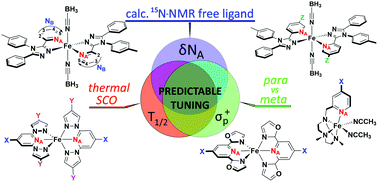Probing the generality of spin crossover complex T½vs. ligand 15N NMR chemical shift correlations: towards predictable tuning†
Abstract
Four new bidentate 5-(Z-pyridine)-4-(4-methyl-phenyl)-3-phenyl-1,2,4-triazole ligands LpytZ (meta-Z = CF3, Br, F, Me) and the corresponding family of [FeII(LpytZ)2(NCBH3)2] complexes, in addition to the literature unsubstituted analogue [FeII(LpytH)2(NCBH3)2], are prepared and studied herein. Single crystal structure determinations on all four new complexes confirmed the expected octahedral coordination, with trans-NCBH3 co-ligands. Solid-state variable temperature magnetic studies of air-dried crystals showed that [FeII(LpytCF3)2(NCBH3)2] is SCO active with a hysteresis loop at 208 K (T1/2↓ = 203 K, T1/2↑ = 213 K; ΔT1/2 = 10 K); [FeII(LpytBr)2(NCBH3)2] is not SCO active until heated above RT, while [FeII(LpytF)2(NCBH3)2] and [FeII(LpytMe)2(NCBH3)2] are SCO active close to RT (T1/2 = 290 and 300 K respectively). Solution phase variable temperature Evans NMR method studies in CDCl3 showed that four of the complexes were SCO active close to RT (T1/2 = 279–294 K) whilst [FeII(LpytCF3)2(NCBH3)2] was mostly LS at RT (T1/2 ∼ 374 K). These solution phase T1/2 values, and those for four literature families of bi- (five Lazine), tri- (fourteen bppX,Y, twelve pyboxX) or tetra-dentate (seven pytacnX) ligands, which feature para (X) pyridine or meta (Y) pyrazole ring substituents, are used, along with the calculated 15N NMR chemical shift of the coordinating azine/azole nitrogen (NA) in the ligand (for all forty-two ligands; using a refined protocol), to test the generality of the previously reported correlation of δNA chemical shift in the free ligand with the solution T1/2 for the respective iron(II) complex. Moderately good to excellent correlations of δNA with T1/2 were observed for each of the ligand families with a para substituent (R2 = 0.69–0.96), whereas there is no correlation when meta substituents are modified (R2 = 0.15–0.37), probably because the electronic impact of this is too small. Finally, δNA also shows promise as an easily calculated measure of the electronic effect of any substituent, in contrast to the Hammett constant (σp+) which is not available for all possible substituents.

- This article is part of the themed collections: 2021 Inorganic Chemistry Frontiers Review-type Articles and 2021 Inorganic Chemistry Frontiers HOT articles


 Please wait while we load your content...
Please wait while we load your content...